2nd December 2006
This, the 25th meeting of the London Youlan Qin
Society, was held at the home of Marnix Wells in Croydon.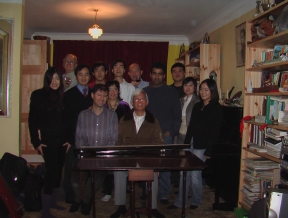
Introduction
The theme of this yaji
was Chan Chong Hin's qin
research, and his Malaysian-made qin.
Programme
First of all, Julian Joseph
introduced our guest, Chan Chon Hin from Malaysia. He had been playing qin for 20 years, and carried out
a lot of research into the qin and
its music.
The Malaysian qin
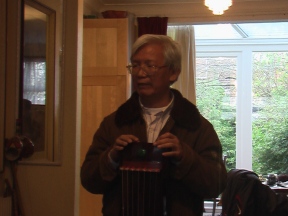 This qin was made by Mr Hew of Kuala
Lumpur. As an architect, he is very particular about design, and that
of this qin is based on a
"whole body" concept. Normally, one feels the qin is an antique instrument. He
made this one according to more modern ideas, and made it very
attractive to look at. On the base there are inscriptions hand carved
by an artist. The body was made in Beijing, using timber from an old
house. It was then shipped to Malaysia, where the surface was
fine-tuned and coated with about seven layers of natural lacquer
over the whole body. The lacquer, from Kaifeng (Henan) had previously
been aged for 5 or 6 years. The shine is natural - no chemicals were
used. After lacquering, the qin was
exposed to microwaves and infra-red radiation to accelerate the effects
of aging. So although it is a new qin,
you can feel that the sound will slowly become mature. The instrument
arrived in Malaysia last January, and is only 10 months old, so the
sound needs more time to gradually improve. Natural lacquer is
different from synthetic lacquer, and after a certain length of time it
changes and can give a better effect.
This qin was made by Mr Hew of Kuala
Lumpur. As an architect, he is very particular about design, and that
of this qin is based on a
"whole body" concept. Normally, one feels the qin is an antique instrument. He
made this one according to more modern ideas, and made it very
attractive to look at. On the base there are inscriptions hand carved
by an artist. The body was made in Beijing, using timber from an old
house. It was then shipped to Malaysia, where the surface was
fine-tuned and coated with about seven layers of natural lacquer
over the whole body. The lacquer, from Kaifeng (Henan) had previously
been aged for 5 or 6 years. The shine is natural - no chemicals were
used. After lacquering, the qin was
exposed to microwaves and infra-red radiation to accelerate the effects
of aging. So although it is a new qin,
you can feel that the sound will slowly become mature. The instrument
arrived in Malaysia last January, and is only 10 months old, so the
sound needs more time to gradually improve. Natural lacquer is
different from synthetic lacquer, and after a certain length of time it
changes and can give a better effect.
The other point about the design of this qin is that the body is thicker
than that of a normal qin. It
is about 10-12mm thick, whereas a normal qin has a thickness of about 8 mm.
Altough a normal qin can
produce a very big sound, that sound is thin, and after aging becomes a
little hollow. By having a thicker surface, the sound is more solid
after aging.
Qin activities in Malaysia
I started learning qin in
1986. In Malaysia there were no masters, no teachers for guqin, so in December 1986 I was
the first guqin player to
put the guqin programme into
concerts. In 1995, Chen Wen, a guqin
player from Taiwan, went to Malaysia with her husband Chen
Guoxing. He also teaches in Malaysia. So the history of the development
of the guqin is very strong
in Malaysia.
Because there was no teacher, I started learning guqin from scores. I learned
fingering from the book by Zhang Shibin on Chinese music history etc.,
which has a section on jianzipu.
I learned quite a lot of pieces from an early (1962) edition of Guqin Quji 古琴曲集. When I later went
to visit Taiwan and Hong Kong, I found that my technique was not
correct! Initially I played the pipa,
and qin friends said, "Oh,
you play the pipa!" So I did
more research and found that guqin fingering
is quite different
from that of guzheng and pipa. The direction of plucking is
quite different. On the guqin you
pluck down, and the sound is reflected from the body of the instrument.
I also do quite a lot of study and research into qin music. I have published quite
a number of articles on an internet forum. Some articles I collected in
my book. I described how to distinguish yin and nao - detailed fingering. I also do
research into guqin pieces,
like Pu'an Zhou. I made quite a complete study of Pu'an Zhou and Shitan Zhang and how these two
pieces differ - actually they come from the same sources. They are all
based on Fujian Nanyin. I wrote a book on this, "Pu'an Zhou Yinyue". I published it
on the internet too, but I think the web site is now gone. They were
started one by one by Beijing University students. The oldest (Fujian
Nanyin) score is from the Ming Dynasty, 17th century. It is a song in
Sanskrit, the pronunciation of the Buddhist syllables, ga, ga, qi, qi, qi etc. Early guqin pieces were also 1 word, 1
sound. After that the pieces were very long, 21 sections. So by the
mid-Qing Dynasty (Wuzhizhai Qinpu),
it had been cut down to 13 sections. The version we play now has almost
12 sections. I can manage 4 versions on the guqin: Shitan Zhang, Wuzhizhai version of
Pu'an Zhou, Xia Yifeng's Pu'an Zhou and the modern Pu'an Zhou. I can also manage versions on the
pipa and sanxian, a total of 6 pieces. It is
quite interesting to study them.
Recently I have been doing some studies on the history of guqin development. I found that
the guqin really developed
during the Han Dynasty, especially the left hand techniques (sliding
etc). Not during the Chunqiu or
before. Before the Qin Dynasty, the qin
was considered very simple, one just plucked the open strings.
From instruments that have survived, it can be seen that the top
surface was carved, so sliding was not possible. I wrote another
article on this a few months ago.
I have also introduced the guqin in
quite a modern way. In Malaysia, and even in China. I use the concept
of "silent music", or jingtai,
the opposite of "dynamic", because the qin is considered a very low
energy instrument. Normally on the violin you have some friction, some
tension, between the bow and the strings. With wind instruments you
need to blow air in, for this too you need quite strong energy. But on
the qin you can play a very
soft sound. The energy of energy is very low, so I call it a low energy
instrument. I use this idea to promote guqin music in my home town, even
in China. Also it is environmentally friendly. Now the trend of the
world is to go at a very fast pace: the guqin can make us slow down and
relax the pressure.
Music
After the talks, the following music was played:
- Liang Xiao Yin 良
宵引 (Music for a Pleasant Evening),
played by Chan Chong Hin.
This version is quite different to the normal version, and is based on
that of Master Xia Yifeng. Mr Chong learned it from Master Li Yuxian of
Fuzhou. *
- Shishang Liu Quan
石上流泉 (A Spring Flowing over Stones),
played by Charlie Huang. From Qinxue
Rumen 琴学入门.
*
- Oulu Wang Ji
鸥鹭忘记 (Without Ulterior Motives),
played by Guan Zhenning. based on a story by Liezi. A
fisherman had a harmonious relationship with the environment, and the
gulls used to play by his boat. One day he told his wife how happy the
gulls were, and she said he should bring one home. So the next time the
fisherman went fishing, he was motivated to try and take a gull. But
the gulls flew high, and never again came within reach. The fisherman
realised that in order to live in harmony with nature, people should
forget bad things.
*
- Guan Shan Yue 关山月 (Moon
Over the Mountain Pass),
played by May Wong. *
- Qiu Feng Ci 秋风词 (Ode to the Autumn Wind),
played and sung by Shigeko Ikezawa. Ichiro Ikezawa read his English
translation of the lyrics:
As the
autumn wind blows away the clouds, the autumn moon appears clearly.
A great number of falling leaves gather and are scattered by
the wind.
Some clouds, which have remained quiet due to the cold of the
autumn night
Are surprised at the sound of these fallen leaves on the ground.
I really do not know when my lover and I will meet again.
I'm very anxious about our future, late on this autumn night,
Because I have nothing to ensure that our future will be happy.
When I suspect my lover, the wind blows into my heart and makes me
writhe around.
When I suspect my lover, the moon lights up my worried face.
As I persist in thinking about him, I tend to remember for a while our
happy days past.
If I think about him for a little while, I cannot resolve the feeling
in my heart.
If I had known the agony of loving him before I had met him,
It would have been natural for me to think we should never have met.
- You Lan 幽兰
(The Solitary Orchid),
played by Dan Nung Ing, based on Guan Pinghu's version. The music is
traditionally associated with Confucius. After traveling and trying to
persuade various leaders to follow his philosophy for good government,
he was unsuccessful. He came to a valley in which wild plants and
weeds were growing in profusion, and amoung them was a single orchid.
In that orchid he saw himself, a fine flower among weeds. #
- Ping Sha Luo Yan 平沙落雁
(Wild Geese Descending on the Level Sand), played by Julian Joseph.
From the Shiyi Xian Guan Qinpu
十一弦管琴谱, published in 1907 by Liu E 刘鹗 (style Tieyun 铁云), a man better
known as a novelist. This version bears a close resemblance to that in
the Wuzhizhai Qinpu
五知斋琴谱. #
- Yangguan San Die 阳关三叠
(Three Variations on the Yang Pass Theme) played by David
Du. #
- Kongzi Du Yi 孔子读易
(Confucius Reads the Book of Changes),
played by Sarah Moyse. In his later years, Confucius was fascinated by
the Book of Changes (Yi Jing 易经). He read it so often that three times
he wore out the leather thongs which held together the bamboo strips of
which the books of the time were made. *
- Guangling San
广
陵散, played
by Marnix Wells. The first part of the version in Shenqi Mipu 神奇秘谱 (1425). #
- Jing Guan Yin 静
观吟 (Observing Calmly),
played by Chan Chong Hin.
Based on the score by Xia Yifeng, and his performance on the collection
of 8 CDs of historical qin recordings.
#
- Pu'an Zhou 普庵咒 (Mantra of Pu'an),
played by Chan Chong Hin.
13 sections. Based on the score by Xia Yifeng, as learned from Li
Yuxian. Li
Yuxian is one of only two students to have learned this piece
from Xia Yifeng. *
- Shitan Zhang
释谈章 (Stanzas of Siddam) (first few
sections only - there are 21 in total - to illustrate how it differs
from Pu'an Zhou, from which
the latter piece is derived), played
by Chan Chong Hin.
Learned from the Hong Kong qin master
Rong Size. *
*
Chan
Chong Hin's qin made
by Mr Hew in Malaysia.
#
Qing Dynasty qin, made in
1804, with silk
strings.
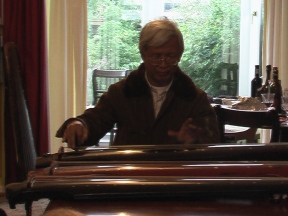
|
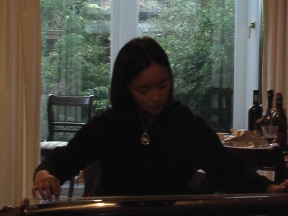
|
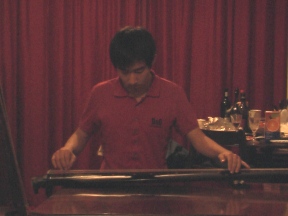
|
Chan Chong Hin playing Liang Xiao Yin
|
May Wong
playing Guan Shan Yue
|
David Du
playing Yang Guan San Die
|
Copyright the London Youlan Qin Society, 2006. All
rights reserved.


 This qin was made by Mr Hew of Kuala
Lumpur. As an architect, he is very particular about design, and that
of this qin is based on a
"whole body" concept. Normally, one feels the qin is an antique instrument. He
made this one according to more modern ideas, and made it very
attractive to look at. On the base there are inscriptions hand carved
by an artist. The body was made in Beijing, using timber from an old
house. It was then shipped to Malaysia, where the surface was
fine-tuned and coated with about seven layers of natural lacquer
over the whole body. The lacquer, from Kaifeng (Henan) had previously
been aged for 5 or 6 years. The shine is natural - no chemicals were
used. After lacquering, the qin was
exposed to microwaves and infra-red radiation to accelerate the effects
of aging. So although it is a new qin,
you can feel that the sound will slowly become mature. The instrument
arrived in Malaysia last January, and is only 10 months old, so the
sound needs more time to gradually improve. Natural lacquer is
different from synthetic lacquer, and after a certain length of time it
changes and can give a better effect.
This qin was made by Mr Hew of Kuala
Lumpur. As an architect, he is very particular about design, and that
of this qin is based on a
"whole body" concept. Normally, one feels the qin is an antique instrument. He
made this one according to more modern ideas, and made it very
attractive to look at. On the base there are inscriptions hand carved
by an artist. The body was made in Beijing, using timber from an old
house. It was then shipped to Malaysia, where the surface was
fine-tuned and coated with about seven layers of natural lacquer
over the whole body. The lacquer, from Kaifeng (Henan) had previously
been aged for 5 or 6 years. The shine is natural - no chemicals were
used. After lacquering, the qin was
exposed to microwaves and infra-red radiation to accelerate the effects
of aging. So although it is a new qin,
you can feel that the sound will slowly become mature. The instrument
arrived in Malaysia last January, and is only 10 months old, so the
sound needs more time to gradually improve. Natural lacquer is
different from synthetic lacquer, and after a certain length of time it
changes and can give a better effect. 

